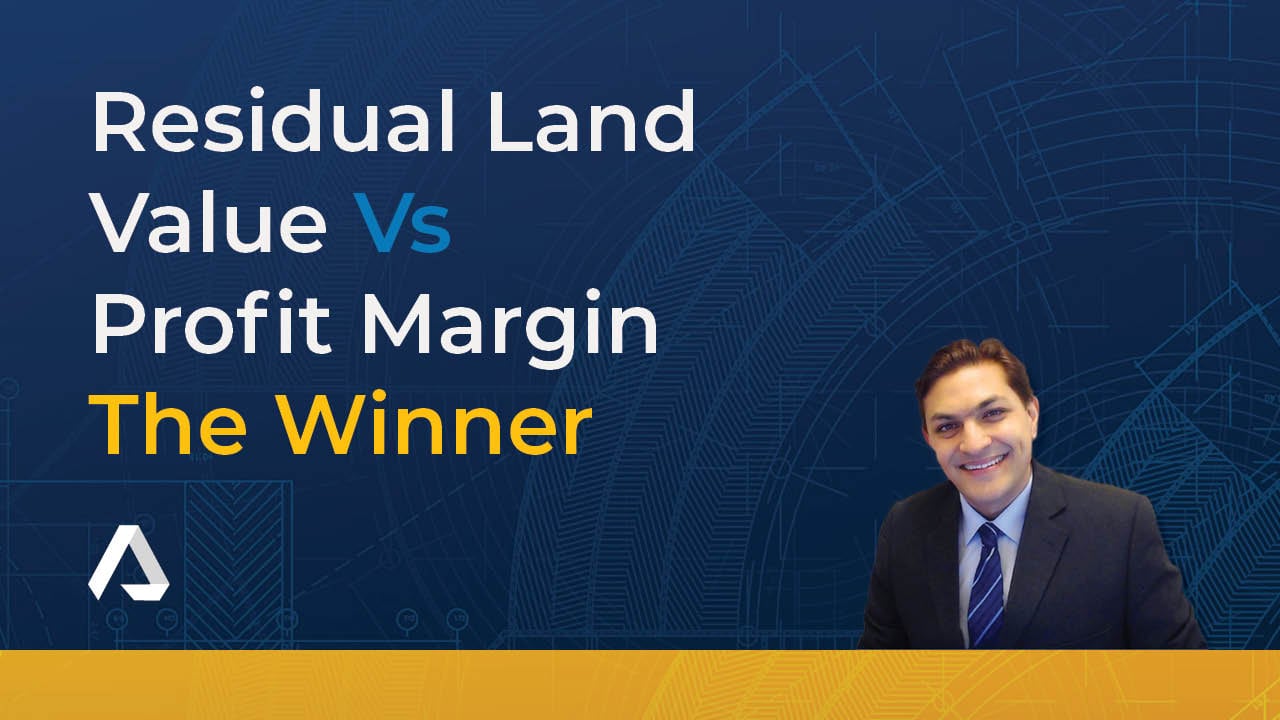Residual land value or property development profit margin: Which is better?
The residual land value & property development profit margin is vital for a real estate developer. The critical difference is that the residual value of land calculation is used to value the cost of land, based on its development potential. In contrast, property development profit margin indicates project profitability on cost and or revenue.
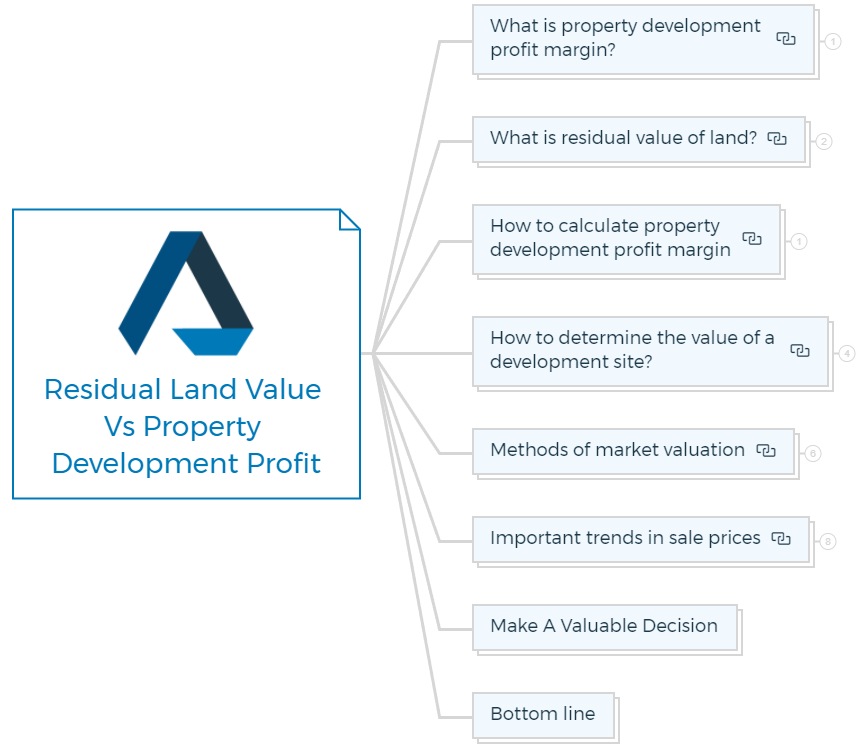
What is property development profit margin?
Property Development profit margin [calculated as a %] is used to determine the residual value of land, i.e. the maximum price you should pay for the potential site/land based on the highest best use or development potential.
When determining the financial viability of a new project, property developers must consider all costs related to the project. All cost elements, such as building costs, professional fees, marketing and sales assumptions, must be projected ahead of time.
The golden rule of a profitable property development project
Project Profit > Project Risk
There are only two essential criteria to consider when analysing the returns or profit in property development: cash flow and net profit.
These formulas do not apply to all projects, and whether they apply to your project relies on your development strategy.

Example: When to use residual profit?
If you were building a home project to sell and the buyers were buying for personal use, the residual profit at the end of the project, which is calculated by subtracting your sales figures from your total expenditure, would be your primary concern.
On the other hand, you would utilise a capitalisation rate to develop a commercial building to sell to an investor.
So, let's start finding out several formulas and logic to analyse the project's viability.
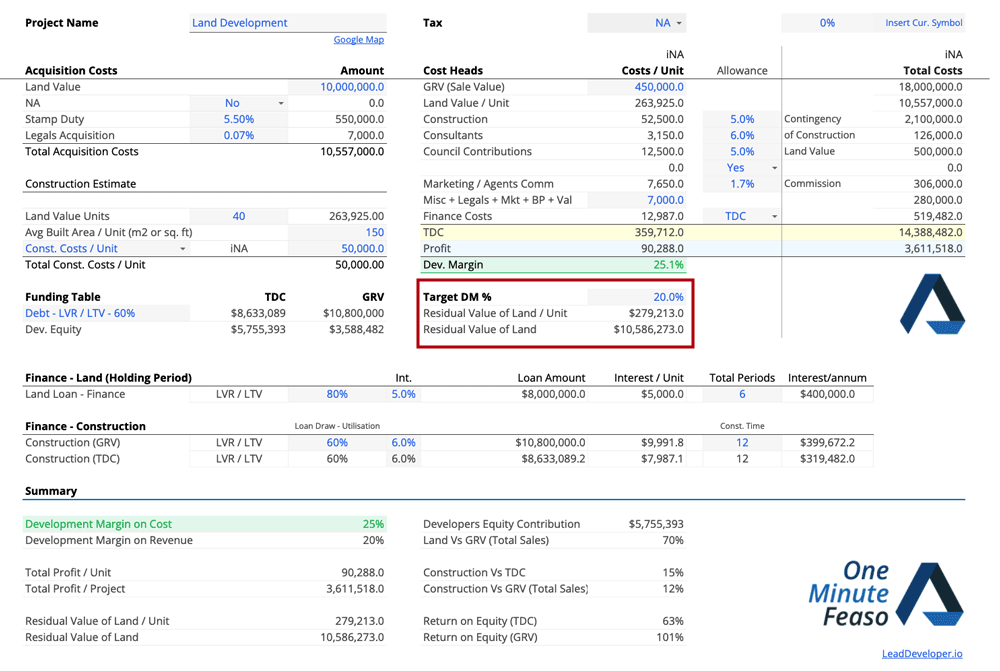
What is residual value of land?
The residual value of land is the value of the land, based on its development potential. Property developers and investors use residual land valuation to determine the maximum price they can afford to pay for the land or development site based on its highest best use and the profit or income it can generate.
The value of any development or investment site is equal to the future cash flow and or profit it can generate.

Project related site value (PRSV)
Residual Value Of Land, sometimes also known as project-related site value, the only difference is that lenders usually commission PRSV to determine the site valuation based on the permit or development approval it holds.
How is residual land value calculated?
It is calculated by deducting all development-related expenditure, including profit, but excluding the land cost, from TDC Total Development Cost.
The balance left over is the residual land value or the maximum amount the developer should pay for the land or site based on the developer's target development margin or return, taking into account the project costs assumed by the developer.
How to calculate property development profit margin
You can calculate real estate development profit in several ways. The bottom line is how much money you have left after all expenses. Let's find it out.


Property development profit margin: The residual profit
The formula for residual profit in real estate is used for simple developments. It follows:
Gross sales revenue ---- $
Less selling expenses ---- $
Net taxable proceeds ---- $
Less taxes ---- $
Net sales proceeds ---- $
Less development costs ---- $
Profit ---- $
The following is an illustration of how this accounting system works:
Total sales (assumed)
Revenue from gross sales - $1500000
Costs of selling - $70000
The expense of construction - $700000
The price of land - $250000
Rate of taxation - 25% (assume)
Therefore:
Revenue from gross sales - $1500000
Less selling expense - $70,000
Net Sales Proceeds - $1430000
Less construction costs - $700000
Less land costs - $250000
Net sales revenues - $480000
Less tax - $120000
Residual profit - $360000
As a result, the profit margin is expressed as a percentage of the cost of development is:
$360000/950000 X 100 = 37.89%
Knowing your numbers is simpler than ever with Property Development Feasibility Suite.
How to determine the value of a development site?
Before purchasing a piece of land for development, consider the financial viability of the project using an equation like this:
Profit = Income - Expenditures
in other words:
Profit = Sales Income - Overall Development Cost
or:
Profit = Sales Income - Construction Cost - Land Value
The developer will estimate sales income and building costs and set a profit hurdle rate or MARR, the required profit margin to make the project viable. These estimates will not be regarded as the variable. A variable in the calculation will be the cost of land.
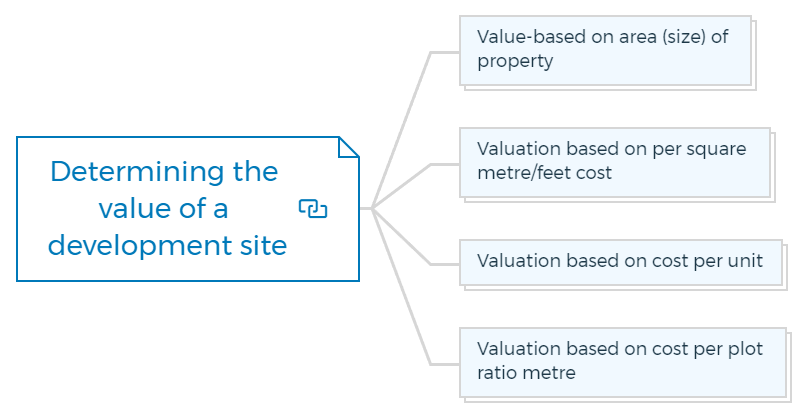
Value-based on area (size) of property
Property measurements are utilised to estimate and compare values when buying land to develop or sell your development. Because other considerations like parking, building lines, height limitations, terrain, and easements might alter the actual value per unit area, this method is utilised primarily as a guide in the early stages of a real estate development's examination.
Valuation based on per square metre/feet cost
The asking price or appraised value is divided by the total square metres of the property to get the price per square metre.
When comparing properties, make sure you utilise the same measurement method. You can measure the property in gross square metres/feet, which is the entire square metres/feet of a property and includes all characteristics such as leased spaces, hallways, stairways, toilet facilities. It is referred to as the building envelope.
On the other hand, net leasable area refers to space leased to tenants but excludes common facilities such as passageways and stairways.
Valuation based on cost per unit
The price per unit is determined by dividing the selling price or appraised value of a property by the number of units. This formula is commonly used in residential projects.
It's crucial to evaluate the price per unit to the land value you're paying for building higher-density residential units or flats.
Check the site zoning because you may be paying the same price per square metre/feet for the same land area, but the second property may have different zoning, allowing you to build one unit less. This will have an impact on the profitability of a real estate development.
Valuation based on cost per plot ratio metre
The price per plot ratio metre benchmark is calculated by dividing a development site's selling price or appraised value by the permissible plot ratio area. This standard is primarily utilized in the construction of commercial structures.
Most commercial construction sites have zoning requirements that specify a maximum plot ratio. Always examine the price per plot ratio metre when purchasing this sort of property, as it will differ from the price per square metre and from property to property.
Get The Edge Now!
Discover the transformative power of our FREE EDGE platform and
unlock a world of opportunities at no cost!
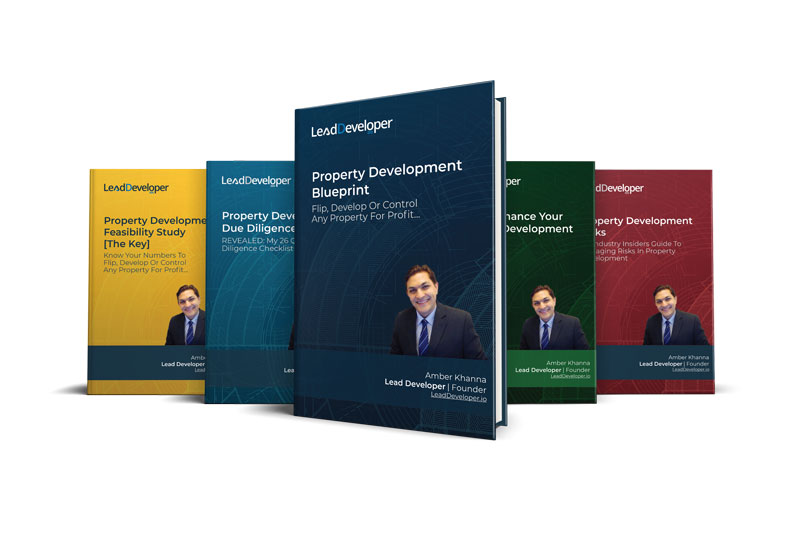
Your Real Estate Toolkit Awaits!
Free eBooks, Courses & Feasibility Suite Trial—Join Today!
✓ Unlimited FREE Trial: Experience the full power of our Feasibility Suite with hands-on demos
—explore without limits, no time pressure & without commitment or credit card!
✓ Learn from Success: Dive into real-life case studies for practical insights.
✓ Engage, Inquire, and Innovate: Ask questions, request features, and engage in lively discussions.
✓ Showcase Your Projects and Gain Insights: Share your projects and get personalised feedback.
✓ Free Resources Galore: Access a treasure trove of free resources,
eBooks & courses to keep you informed.
✓ Exclusive Training: Enjoy members-only training to sharpen your skills.
Methods of market valuation
At the end of the property development project, every property developer wants to know the target market worth or sales figure.
There are three methods for determining your property development profit. They are as follows:
- Direct market comparison
- The approach to actual costs
- The method of income

Direct market comparison
When valuing undeveloped land and housing developments, the direct market comparison is helpful. Similar previously sold properties would be analysed and compared to the planned new development using this method.
As illustrated below, the expected selling figure should be adjusted to account for any discrepancies between the old and new proposals:
Comparable property sales +/-adjustments = development's projected market value.
The developer subtracts the construction and land costs from the anticipated value to find an estimated profit.
Anticipated profit = estimated market value - building and land costs.
The actual cost Method
The actual cost approach entails estimating the building and land costs and profit margin based on the project's risk level.
Estimated market value = estimated construction cost + estimated land cost + estimated profit margin percentage
Most property developers dislike this strategy since it does not consider its actual market value, leaving the developer with properties they cannot sell.
The method of income
This approach values development based on its quality and quantity. The process has three main steps: first, the rental space's net operating income (NOI) potential must be calculated using comparable properties.
Second, determining the capitalisation rate by comparing the rates of return on comparable investments with similar features. The third is the recommended market value calculated by dividing the net estimated income by capitalisation.
#1 - Net operating income
To compute the NOI, start by calculating the gross potential income (GPI), the total potential income that the development can create. Second, subtract a potential vacancy rate and net operational expenses (OE).
The total income obtained from development is referred to as gross potential income. It includes:
- All rental income is calculated on a per-unit (residential) or per-square-meter basis ( commercial).
- Other sources of income include parking, cleaning, and garden maintenance.
The vacancy rate is calculated using a percentage factor that varies depending on the type of development and market conditions.
Operating expenses are the costs of running the completed property daily, which include:
- Fixed expenses - These are the expenses that have a fixed cost and are thus more predictable. Council rates, insurance, and property management are part of this category.
Variable expenses - These are the expenses that change over time and include repairs and upkeep, commissions on marketing, supply, and leasing.
#2 - Calculate the capitalisation rate
The capitalisation rate (CR), often known as the yield, is the rate of return on the property's worth. Based on the associated risk and the management level required, each form of the property will have a different capitalisation rate.
Remember that the higher the capitalisation rate, the more significant the risk in the development.
Before you start employing a capitalisation rate, do your homework on the going rate for the type of property you're building or the location where you're proposing.
#3 - The computation
You can use the formula below to calculate the proposed development value using the information gathered in steps 1 and 2.
Property Valuation (V) = Net Operating Income / Capitalisation Rate
Some well-known commercial property developers are looking to sell to institutional investors. These developers will seek the highest possible net operational revenue while incurring the fewest capital costs, resulting in a high capitalisation rate or return on capital.
They'll sell the project to an institutional investor at a lower capitalisation rate before starting construction, lowering their risk and ensuring 100% financing.
Important trends in sale prices
Not only should attention be made to forecasting the yearly gross earnings when evaluating the predicted sale prices in development, but also to changes in trends and factors that may affect the supply and demand for property.
The following is a list of factors that could change current patterns and, as a result, affect supply and demand.
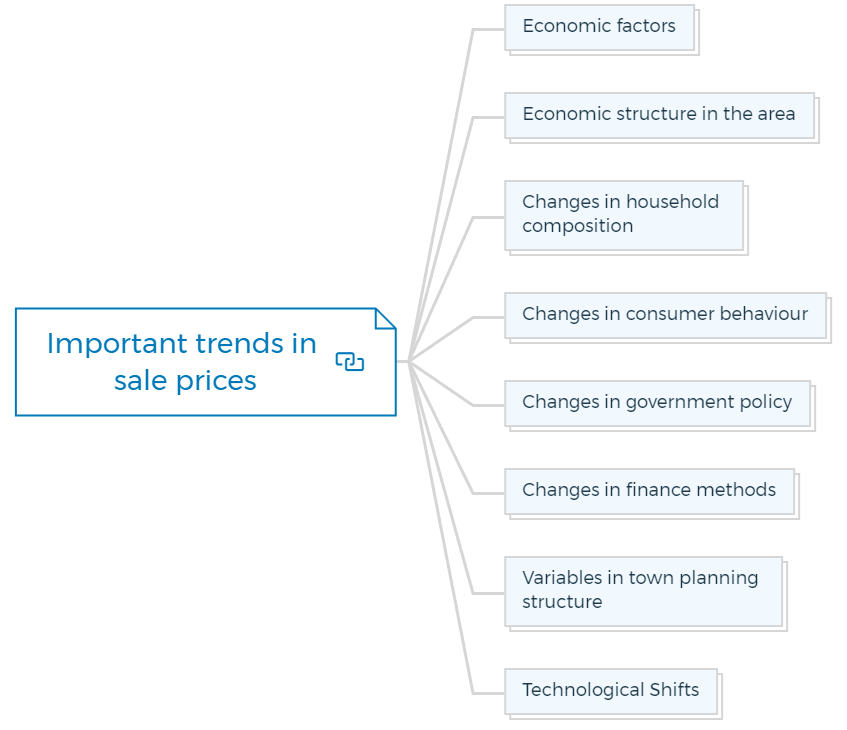
Economic factors
- Rates of employment
- The economic & business cycle
- The impact of new technologies on employment.
Economic structure in the area
- Decreases in community services
- Significant industries in the area
Changes in household composition
- Expectations for childbearing
- Age Group Distribution of the Population
- Marriage preparations
Changes in consumer behaviour
- Certain styles are preferred.
- Certain amenities are preferred
- Location is a priority.
Changes in government policy
- Legislation on taxation
- Environmental concerns
- Constraints in development
Changes in finance methods
- New methods for raising funds
- Syndications
- Property trusts
Variables in town planning structure
- Redevelopment of cities
- Zoning changes
- Systems of transportation
Technological shifts
- Telecommunicates
- The internet and computers.
Make a valuable decision
Examine the different aspects and methodologies relevant to the property type to assess if development is worthwhile.
Review your return requirements, expected length of involvement in the project, the personal time required to generate this possible profit, the risk involved with this type of development, and any personal guarantees you may be required to make.
Determine which development will be more successful if the opportunity to develop more than one property comes.
Register for the Structured Property Development Courses - Pave your way to success.
Bottom line
Developers use profit and various calculations to determine their success. It's a good idea to include a few safety factors in these assumptions and calculations; it's better to be astonished at your profit after the transaction than disappointed, especially if the project is late and over budget.
Developers and their development teams should first identify the numerous categories that are bound to be faced before putting figures on paper.
Rather than underestimating prices, most viability problems are caused by developers or their teams overlooking essential elements. To assess whether development should proceed, wise developers should utilise formulas like those explained above to analyse cash flows and capitalisation rates.
To know your numbers well, Choose the correct option - One Minute Feaso!
FAQs


